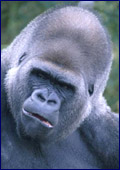The Great Apes
Updated February 21, 2017 | Factmonster Staff 

The Great Apes
Fast facts on these amazing animals
Read great ape profiles |
There are four kinds of great apes: gorillas, orangutans, chimpanzees, and bonobos. Gorillas, chimpanzees, and bonobos live in groups in Africa. Orangutans live in Indonesia and spend much of their time alone.
Some scientists think that humans should be considered great apes, too. Chimpanzees share more genetic material with humans—about 99%—than they do with gorillas.
Some scientists think that humans should be considered great apes, too. Chimpanzees share more genetic material with humans—about 99%—than they do with gorillas.

Ape or Monkey?
Apes are not monkeys. Apes are larger, have fewer young (and spend a longer time raising them), spend more time upright, and depend more on their eyes than on their noses. And unlike monkeys, apes do not have tails. But the most important difference is that apes are more intelligent than monkeys. Their brains are larger and more developed, and apes can learn and pass along information.
A Long Childhood
Some animal babies are on their own from the moment they are born. But great apes are born helpless and must be carefully nurtured by their mothers. In its first few years an infant great ape is always with its mother, and most remain close for years afterward. A young great ape must spend years learning about the world and how to behave in its community. After all, it will be part of a community for 30 to 50 years.
|
Please Pass the Banana
Apes' hands are prehensile (capable of grasping things), and so are their feet. Like us, apes have flat fingernails and complicated fingerprints. But unlike us, their bodies are designed to be most comfortable walking on all fours. Apes have arms longer than their legs, and walk on the knuckles of their hands.
Oh, That Face
What makes the great apes so fascinating? Maybe it's because they remind us of ourselves. Often they use gestures and facial expressions that look much like ours—but in fact these may have a very different meaning. For example, what looks like a big smile on a chimpanzee may be a "fear grin" that means it is scared.
Talk to Me!
Researchers have taught a kind of signed language to great apes in captivity. All four kinds of great apes have been able to learn it, though none use it in the wild. Koko, a famous gorilla, uses about 1,000 signs. None of the apes can speak as we do, though, because their vocal cords are different.
| Read Great Ape Profiles |
See also:
